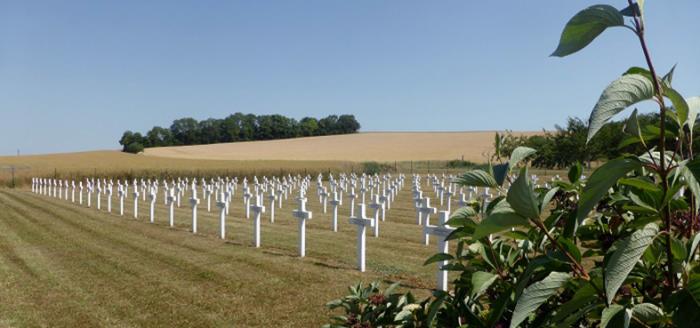
Dieue National Cemetery. © Guillaume Pichard
Click here to view the cemetery’s information panel 
Dieue National Cemetery contains the remains of French soldiers killed in the fighting in Hauts de Meuse between 1914 and 1918. Established in 1914, the cemetery contains the bodies of soldiers who died in the medical facilities installed in the village. In 1922, the site was redeveloped and, until 1927, it also held bodies exhumed from the cemeteries of neighbouring villages (Ailly-sur-Meuse, Dugny-sur-Meuse, Les Éparges, Haudainville, Maizey, Mouilly, Ranzières, Vacherauville and Vaux-lès-Palameix). Covering an area of 2 025 m², the cemetery contains over 300 French soldiers buried in individual graves.
The fighting in Hauts de Meuse
Due to the French push across the Marne and the resistance of Fort Troyon, on 13 September 1914 the German Fifth Army retreated. It fell back onto the marshy plain of the Woëvre, where it took up positions prepared in advance. On 20 September, the Germans attacked from Étain to Pont-à-Mousson and succeeded in reaching the Meuse at Saint-Mihiel. Within a few days, they had carved out a salient in the French front, but were stopped by the 16th Army Corps. The Germans dug themselves solidly into their positions. Lying between Verdun and Saint-Mihiel, this sector was the scene of bloody fighting in 1915. At the Calonne Trench, Bois des Chevaliers, Bois d’Ailly and Bois Brûlé, the infantry were severely put to the test. Throughout the war, these sectors, to the south of Saint-Mihiel, were among the most active.
Dominating the plain, the Les Éparges ridge was at the centre of fierce fighting, in which thousands died. The summit of the hill was blown up by underground mines dug by sappers on both sides. Between 5 and 14 April 1915, the French 1st Army attacked in Woëvre and Hauts de Meuse. Faced with strong enemy resistance, it was unable to seize the ridge.
From 22 to 26 February 1916, in view of the German pressure on Verdun, the French evacuated Woëvre to fall back around Fort Moulainville, which had been bombed for weeks by the Germans. In 1917, due to a shortage of troops, the front came to a standstill until the Franco-American offensive against the Saint-Mihiel salient. Launched on 12 September 1918, the offensive was brought by nine American and four French divisions, supported by 3 000 guns, 1 500 aircraft and 200 tanks. It succeeded in driving the enemy back to the border, taking 16 000 prisoners. The front then stabilised until the armistice of November 1918.
Dieue, a nearby village of medical facilities
During the operations of 1915, many troops were stationed in Dieue, along with two headquarters. Declared a military hospital, the village received large numbers of wounded, in particular those of the 68th and 28th divisions. The 2/14 field ambulance was divided between several houses in the village, one of which (on Place du Jeu-de-Quilles) still bears a red cross on its façade. Having gone through triage by the divisional ambulances at Calonne, the seriously wounded underwent surgery and treatment here, before being taken to Petit-Monthairon evacuation hospital, then on to the hospital of Queue-de-Mala. Lastly, they were evacuated by train or ambulance car to the hospitals of Bar-le-Duc.
The soldiers who died in 1915 belonged to the 8th, 11th, 51st, 67th, 106th, 110th, 128th and 132nd Infantry Regiments (IR) and the 25th Battalion of Chasseurs Portés (BCP), whose divisions fought at Les Éparges or the Calonne Trench. In Petit-Monthairon, there still stands a burial stone bearing the numbers of the units that were buried there and are today buried at Dieue. Just after the war, a memorial was erected to the 284 soldiers then buried on this site. It lists the names of the units of all the soldiers buried here, who came from across France and its colonies.